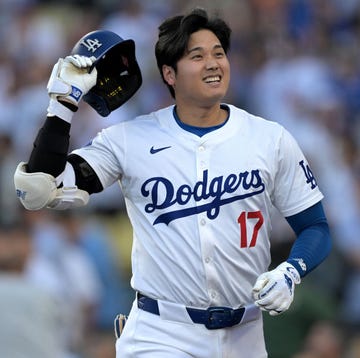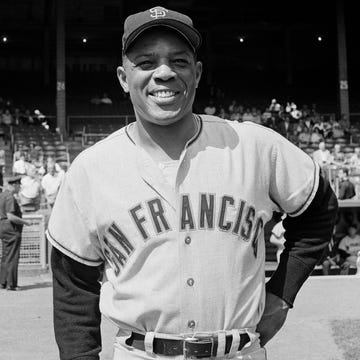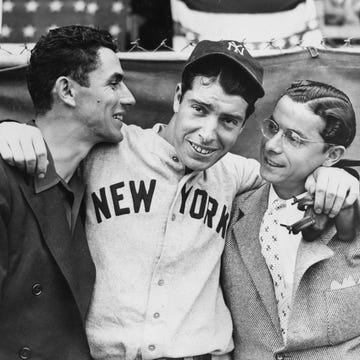From the “Sultan of Swat” to the “Colossus of Clout,” no baseball player has inspired more attention-grabbing nicknames than George Herman Ruth. But there’s one moniker for the legendary Babe you might not know: cancer pioneer.
Babe Ruth, the fearsome slugger who hit 714 home runs and won seven World Series, battled advanced-stage cancer in the final years of his life. In the process, he became one of the first chemotherapy patients anywhere and helped alter the course of medicine. Friday marks 76 years since his death at age 53, but the findings from his experimental treatment still reverberate in cancer care today.
Ruth didn’t prioritize his health when he was young
Ruth, born in February 1895, was the undisputed king of baseball by his 30th birthday. By 1925, he had won four World Series—three with the Boston Red Sox and another following his infamous December 1919 trade to the New York Yankees—and established himself as the sport’s most fearsome hitter. He set a new single-season home run record three straight seasons, culminating with 59 round-trippers in 1921.
But the Great Bambino also developed a reputation as a glutton when he wasn’t on the field. According to the National Hot Dog and Sausage Council, Ruth reportedly once ate 12 franks and drank eight bottles of soda during a doubleheader. He also smoked cigars and drank whiskey for breakfast. Yankees teammate Joe Dugan once summed up Ruth’s routine as, “Day and night, broads and booze.”
These habits eventually caught up to Ruth. According to The Citizen-Times, the slugger arrived with the Yankees in Asheville, North Carolina, on April 7, 1925, for an exhibition game against the Brooklyn Dodgers. Upon reaching the train station, Ruth told teammates he felt “indisposed” and lost consciousness, collapsing on the platform.
Ruth’s illness was attributed to “acute indigestion” caused by his poor diet, though his collapsed sparked rumors that he died on the subsequent train ride back to New York. This wasn’t true, but Ruth did have surgeries to remove an intestinal abscess and ulcer.
A baseball suspension led Ruth to improve his habits
However, his return to the field later in 1925 didn’t last long. Yankees Manager Miller Huggins suspended Ruth indefinitely in late August for misconduct. “Patience has ceased to be a virtue. I have tried to overlook Ruth’s behavior for a while, but I have decided to take summary action to bring the big fellow to his senses,” Huggins said, according to The New York Times.
Ruth seemed to get the message and began taking better care of himself, as well as his family. In 1926, his batting average rose 80 points, and the following year, he swatted 60 home runs—breaking his own major league record. Ruth continued playing baseball through 1935 and became a member of the original five-player class for the National Baseball Hall of Fame.
The outfielder also experienced major changes at home. By the mid-1920s, Ruth had separated from his first wife, Helen, with whom he was raising a daughter, Dorothy. In April 1929, Ruth married his second wife, Claire Hodgson, and adopted her daughter, Julia.
Julia had a close relationship with Ruth, who taught her how to dance and bowl and even flew her to Japan for a 1934 event with the major league all-stars. “I couldn’t have had a better father than him,” Julia later said.
Ruth might have even saved her life. On August 7, 1938, The New York Times reported Julia, who had been hospitalized for weeks with strep throat and needed a blood transfusion, received a pint of blood from her dad. Less than a decade later, Ruth found himself back at the hospital in even more dire circumstances.
Ruth became one of the first chemotherapy patients
After baseball, Ruth remained a huge celebrity. An avid golfer, he participated in matches with stars like fellow Hall of Famer Ty Cobb, Masters winner Jimmy Demaret, and legendary Olympian Babe Didrikson Zaharias, whose nickname he inspired. He also visited troops and helped promote war bond drives during World War II. So, when Ruth became severely ill in 1946, it’s little surprise he had to access to the most contemporary medicines available.
According to the Mayo Clinic Proceedings journal, Ruth began experiencing hoarseness and headaches behind his left eye. Although it was initially believed to be throat cancer, doctors eventually determined Ruth had nasopharyngeal carcinoma, or cancer of the tissue connecting the back of the nose and mouth called the nasopharynx. The illness also metastasized to his lymph nodes, constricting his carotid artery. Amazingly, it’s unclear if Ruth even knew the extent of his illness, as it was commonplace at the time for doctors to shield patients from terminal diagnoses.
Although Ruth underwent radiotherapy and surgery, the tumor persisted, and he began losing weight and muscle mass. In February 1947, the once-hulking figure spent his 52nd birthday in the hospital and was completely despondent. “I often felt so alone that the tears would run helplessly down my cheeks,” Ruth later wrote in his autobiography.
Later that year, Dr. Richard Lewisohn and researchers at Mount Sinai Hospital of New York City suggested that Ruth participate in a clinical trial for the experimental drug teropterin, which had only been tested on rats. Teropterin was a precursor to methotrexate, a chemotherapy drug used today to treat various forms of cancer and other diseases.
Ruth, who didn’t want to know what drug he was receiving or why, agreed and underwent six weeks of daily treatment—making him one of the first patients anywhere to receive chemotherapy. Additionally, Dr. Nadim Bikhazi told Popular Science in 2018 that Ruth might have been the first patient to receive sequential radiation and chemotherapy treatment, now known by the somewhat crude shorthand “chemo-beamo.”
Ruth’s plight and his unproven treatment made it to the big screen in the 1948 biographical movie The Babe Ruth Story. In the final act of the film, doctors offer a dying Ruth an unspecified experimental serum to combat his illness.
Ruth’s treatment informed cancer treatment for years to come
To the surprise of doctors, Ruth’s teropterin treatments were initially effective. His glandular swelling decreased, and the severity of his symptoms diminished. According to Mayo Clinic Proceedings, his encouraging case was anonymously presented at a research conference in September 1947. Outlets such as Time and The Wall Street Journal soon reported that scientists had possibly found a cure for cancer.
That wasn’t true, of course. Ruth experienced a quick recurrence of his illness despite the novel drug. He was so sick at a screening of The Babe Ruth Story, writes journalist Noah Gittell in his 2024 book Baseball: The Movie, he had to leave midway through the movie to return to the hospital. And soon, the more potent aminopterin became the preferred cancer treatment.
Still, Ruth’s case proved a milestone in medicine. Even though Ruth only lived another year, the chemo-beamo method expanded his lifespan well beyond the typical prognosis of the time.
On August 16, 1938, Ruth died at Memorial Hospital in New York City after catching pneumonia. Tens of thousands of mourners paid their respects while his body lay in state for two days at the original Yankee Stadium, nicknamed the “House That Ruth Built.” They also lined the streets around the famous St. Patrick’s Cathedral during his funeral service. In the decades since, fans have left baseball bats, whiskey, hot dogs, and more at Ruth’s grave in Gate of Heaven Cemetery in Hawthorne, New York, as tributes to the great Bambino.
Ruth’s legacy as a heroic figure stems largely from his accomplishments on the baseball diamond, but his impact in medicine is just as significant. According to Popular Science, chemotherapy didn’t become widely available until the 1950s. But thanks to Ruth and other study participants, treatments are much more potent and targeted today. By 1998, 40 percent of patients with advanced nasopharyngeal cancer, the kind Ruth developed, had a survival rate of five or more years.
“I realized that if anything was learned about that type of treatment, whether good or bad,” Ruth wrote in his autobiography, “it would be of use in the future to the medical profession and maybe to a lot of people with my same trouble.”
Tyler Piccotti joined the Biography.com staff as an Associate News Editor and is now the News and Culture Editor. He previously worked as a reporter and copy editor for a daily newspaper recognized by the Associated Press Sports Editors. In his current role, he shares the true stories behind your favorite movies and TV shows and profiles rising musicians, actors, and athletes. When he's not working, you can find him at the nearest amusement park or movie theater and cheering on his favorite teams.
















